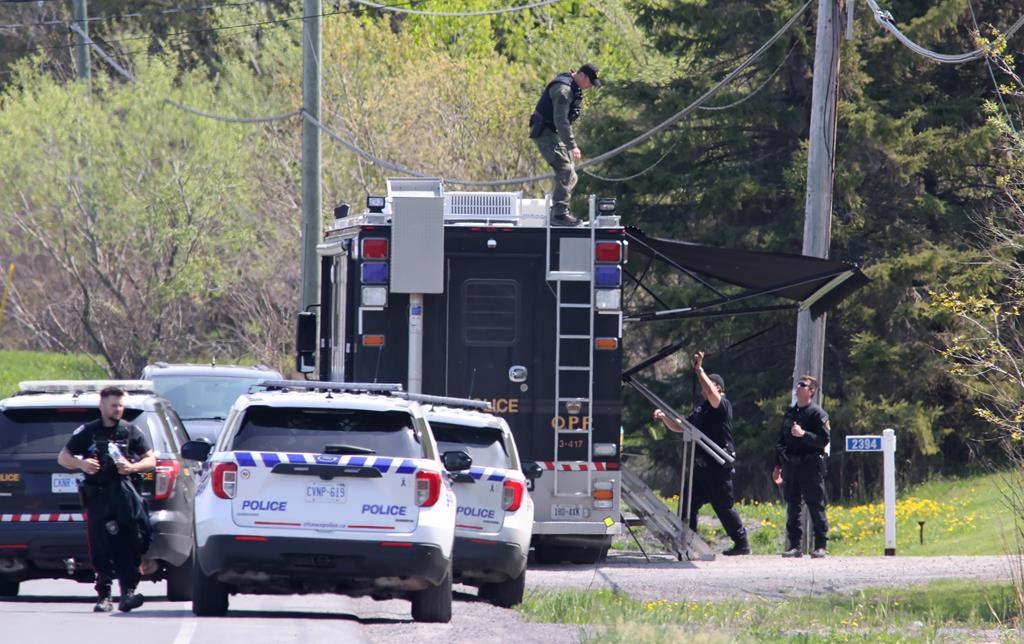In The News for May 12 : Investigation continues into deadly OPP ambush

Posted May 12, 2023 4:15 am.
Last Updated May 12, 2023 4:16 am.
In The News is a roundup of stories from The Canadian Press designed to kickstart your day. Here is what’s on the radar of our editors for the morning of May 12 …
What we are watching in Canada …
One Ontario Provincial Police officer remains in hospital as the investigation continues into an ambush that left one officer dead and two injured.
Officials say Sgt. Eric Mueller was fatally shot Thursday when he and the two other officers responded to a disturbance call at a home in Bourget, Ont., east of Ottawa.
OPP Commissioner Thomas Carrique said the three officers had called for backup before they approached the house, and all were shot upon arrival.
One officer was seriously injured and is in hospital while the other injured officer has since been released and is recovering at home.
Alain Bellefeuille, a 39-year-old Bourget resident, is charged with one count of first-degree murder and two counts of attempted murder.
Mueller is the fifth police officer to be fatally shot in Ontario since September.
In Ottawa, Prime Minister Justin Trudeau said he was working with his ministers of justice and public safety to look at ways to protect officers given the rash of deadly shootings.
“This has to stop. We need to be there to protect the people who put their lives on the line every day to protect the rest of us.”
—
Also this …
A search for the remains of two First Nations women at a Winnipeg-area landfill could take up to three years and cost $184 million, says a study examining whether a successful search is possible.
The study, obtained by The Canadian Press, looked at the various scenarios and challenges that come with searching a landfill and concluded a canvass of the Prairie Green Landfill is feasible.
It warns there are “considerable risks” due to exposure to toxic chemicals and asbestos. It also acknowledges there is no guarantee a search would locate the women’s remains. But it says forgoing a search could be more harmful for the families of Morgan Harris and Marcedes Myran.
“Not conducting the search could cause considerable distress to victim family members,” the report says.
“The impact of not conducting a search and humanitarian recovery for remains of Morgan and Marcedes, when it is possible that they are in the Prairie Green Landfill, could have long-lasting repercussions on the families, friends, loved ones and First Nations and Indigenous communities in Manitoba and across Canada.”
The Assembly of Manitoba Chiefs and representatives from Long Plain First Nation, to which Harris and Myran belonged, are to hold a news conference Friday about the study.
An Indigenous-led committee spearheaded by the Assembly of Manitoba Chiefs commissioned the study after Winnipeg police said in December that they believed the remains of Harris and Myran are in the landfill north of the city. But police said they would not be searching the site because of the passage of time and the large volume of material deposited there.
The committee included family members, First Nations leaders, forensic experts and representatives from the province and the city.
—
What we are watching in the U.S. …
EL PASO, Texas _ Pandemic-related asylum restrictions that expelled migrants millions of times were lifted early Friday, as people raced to enter the United States before new rules announced by U.S. President Joe Biden’s administration set in.
Meanwhile, the administration was dealt a potentially serious legal setback when a federal judge temporarily blocked its attempt to release migrants more quickly when Border Patrol holding stations are full.
Migrants, including children, in northern Mexico paced along a U.S. border strung with razor wire and bolstered by troops, unsure of where to go or what to do next. Others settled into shelters, determined to secure an asylum appointment that can take months to schedule online.
At Matamoros, across the Rio Grande from Brownsville, Texas, migrant families hesitated only briefly as the deadline passed and asylum restrictions shifted before entering the waters of the Rio Grande from Mexico, holding cellphones above the water to light the way toward the U.S.
U.S. authorities shouted for the migrants to turn back.
“Be careful with the children,” an official shouted through a megaphone. “It is especially dangerous for the children.”
The expired rules, known as Title 42, were in place since March 2020. They allow border officials to quickly return asylum seekers back over the border on grounds of preventing the spread of COVID-19.
U.S. authorities have unveiled strict new measures, which crack down on illegal crossings while also setting up legal pathways for migrants who apply online, seek a sponsor and undergo background checks. If successful, the reforms could fundamentally alter how migrants arrive at the U.S.-Mexico border.
—
What we are watching in the rest of the world …
Officials from Japan and South Korea eyed a potential visit by South Korean experts to the Fukushima nuclear plant before it begins the controversial release of treated but radioactive water to sea. It’s one of their major sticking points between the two sides that are quickly thawing long-strained ties.
Discussions were to take place later Friday, and the Japanese government was expected to give updates on the status of the tsunami-wrecked Fukushima Daiichi nuclear plant, which is preparing for a release of the water, saying it’s an unavoidable step to move its decommissioning process forward.
The government and the plant’s operator, Tokyo Electric Power Company Holdings, say the release will begin between spring and summer and take decades to finish.
A massive earthquake and tsunami in 2011 destroyed the Fukushima Daiichi plant’s cooling systems, causing three reactors to melt and release large amounts of radiation. Water used to cool the three damaged reactor cores, which remain highly radioactive, leaked into the basements of the reactor buildings and was collected, treated and stored in about 1,000 tanks that now cover much of the plant.
The government and TEPCO say the tanks must be removed so that facilities can be built for the plant’s decommissioning, while minimizing risks of leaks in case of another major disaster. The tanks are expected to reach their capacity of 1.37 million tons in spring 2024.
Japanese Prime Minister Fumio Kishida, during his May 7-8 visit to Seoul for a summit with South Korean President Yoon Suk Yeol, announced that Japan will receive a team of experts to visit the plant later in May to address South Korea’s concerns in a show of his enthusiasm to further improve relations.
Seoul wants to send some 20 government experts to visit Fukushima Daiichi plant May 23-24, although the group’s size would be determined after talks with Japan, according to South Korean officials. Japan was reluctant to accept private experts, saying it’s a government-to-government matter.
Japan is expected to give them a tour _ not a safety inspection _ of the plant.
—
On this day in 1971 …
Medicare became a truly national program when New Brunswick became the last province to sign on by proclaiming its Health Services Act.
—
In entertainment …
“BlackBerry” director Matt Johnson is enjoying the controversy simmering around his latest film.
Over the past month, some of the most influential people in Canada’s technology and business circles settled into sneak preview screenings of his darkly comedic spin on the rise and fall of the beloved Waterloo, Ont.-created smartphone.
And many emerged deeply confounded by what they saw.
After one Toronto screening a week ago, a group of former employees at BlackBerry-maker Research In Motion gathered over drinks to discuss a mixture of Canadian pride and confusion they were feeling about the film’s revisionist history of the company.
As “BlackBerry” heads to theatres countrywide this weekend, amid heaps of buzz and critical raves, the film faces its share of sour notes from those unhappy with how freely — some say even carelessly — it plays with the truth.
Earlier this week, RIM’s former chief financial officer Dennis Kavelman published an opinion piece in the National Post calling the film an “obvious, lazy portrayal of tech bro culture” that “seems to go out of its way to diminish and tarnish the legacy of the founders and employees of one of Canada’s great technology stories.”
And a recent 18-minute YouTube video by former RIM employee Matthias Wandel – who also served as one of the production’s consultants – ripped apart the accuracy of the movie trailer without having seen the film itself.
“BlackBerry” is very loosely based on “Losing the Signal,” a 2015 book by reporters Jacquie McNish and Sean Silcoff. The film effectively takes their facts and feeds them through a paper shredder before reassembling the jagged remnants of familiarity.
Former co-CEO Jim Balsillie is played by “It’s Always Sunny in Philadelphia” actor Glenn Howerton as a nefarious troublemaker. His business partner Mike Lazaridis is portrayed by Ottawa-born Jay Baruchel as a socially inept visionary.
Johnson rounds out the trio of leads as RIM co-founder Doug Fregin, a composite of various employees and elements of fiction.
“Look, the fact that a Canadian movie is even getting this kind of attention is a miracle,” Johnson said last month during a run of press interviews.
“(That) there would be some comment on accuracy in portrayal or whatever, to me, is a compliment.”
—
Did you see this?
The co-chair of a Canadian health panel says there’s no need for women to start having routine mammograms at age 40, despite new draft recommendations from an American task force calling for that change.
Dr. Guylène Thériault of the Canadian Task Force on Preventive Health Care said she does not see any reason to change the guidelines. Regular mammography screening is currently recommended in both countries for women between the ages of 50 and 74.
However, Hannah Jensen, a spokeswoman for the Health Ministry in Ontario, said Thursday the province is “exploring” lowering the breast cancer screening age to 40. British Columbia will also review the U.S. draft recommendations to determine if any changes will be made to its screening program, the province’s health minister said.
The U.S. Preventive Services Task Force released draft recommendations Tuesday saying screening for average-risk women should start a decade earlier and be done every two years because recent evidence suggests that would have a “moderate benefit” in reducing deaths.
Thériault said the Canadian task force does not intend to update guidelines set in 2018 because the benefits of earlier screening do not outweigh the risks of false-positive results and overdiagnosis when harmless tumours are detected.
Out of 2,000 women who are screened over a decade between the ages of 40 and 49, one woman would die of breast cancer. About 295 false-positives would be detected among those cases, she said.
“Looking at the guidelines, we don’t see that there was anything new and we were a bit surprised,” Thériault said of the U.S. task force’s draft recommendations.
“In Canada, what we are saying is women should be empowered. They should have the information that they need to make a decision,” she said about the pros and cons of earlier mammograms.
Women should ask a family doctor for screening if there is a history of breast cancer in their family or if they have any specific concerns, Thériault added.
In its draft recommendations, the U.S. task force cited two studies that suggest there is adequate evidence of the “small” harms of biennial screening mammography, including false-positive results, when younger women are screened. It said false-positives are more likely with annual mammograms compared with longer intervals between screening.
—
This report by The Canadian Press was first published May 12, 2023
The Canadian Press








